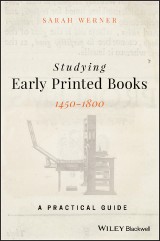Details

Studying Early Printed Books, 1450-1800
A Practical Guide1. Aufl.
|
18,99 € |
|
| Verlag: | Wiley |
| Format: | |
| Veröffentl.: | 13.12.2018 |
| ISBN/EAN: | 9781119049944 |
| Sprache: | englisch |
| Anzahl Seiten: | 208 |
DRM-geschütztes eBook, Sie benötigen z.B. Adobe Digital Editions und eine Adobe ID zum Lesen.
Beschreibungen
<p><b>A comprehensive resource to understanding the hand-press printing of early books</b></p> <p><i>Studying Early Printed Books, 1450 - 1800</i> offers a guide to the fascinating process of how books were printed in the first centuries of the press and shows how the mechanics of making books shapes how we read and understand them. The author offers an insightful overview of how books were made in the hand-press period and then includes an in-depth review of the specific aspects of the printing process. She addresses questions such as: How was paper made? What were different book formats? How did the press work? In addition, the text is filled with illustrative examples that demonstrate how understanding the early processes can be helpful to today’s researchers.</p> <p><i>Studying Early Printed Books</i> shows the connections between the material form of a book (what it looks like and how it was made), how a book conveys its meaning and how it is used by readers. The author helps readers navigate books by explaining how to tell which parts of a book are the result of early printing practices and which are a result of later changes. The text also offers guidance on: how to approach a book; how to read a catalog record; the difference between using digital facsimiles and books in-hand. This important guide:</p> <ul> <li>Reveals how books were made with the advent of the printing press and how they are understood today</li> <li>Offers information on how to use digital reproductions of early printed books as well as how to work in a rare books library</li> <li>Contains a useful glossary and a detailed list of recommended readings</li> <li>Includes a companion website for further research </li> </ul> <p>Written for students of book history, materiality of text and history of information, <i>Studying Early Printed Books </i>explores the many aspects of the early printing process of books and explains how their form is understood today. </p>
<p>List of Illustrations vii</p> <p>Acknowledgments ix</p> <p>Introduction 1</p> <p><b>Part 1 Overview 8</b></p> <p>Getting Ready to Print 8</p> <p>At the Press 16</p> <p>Also at the Press 19</p> <p>After Printing 20</p> <p>The Economics of Printing 23</p> <p><b>Part 2 Step-by-Step 26</b></p> <p>Paper 26</p> <p>Type 34</p> <p>Format 42</p> <p>Printing 55</p> <p>Corrections and Changes 61</p> <p>Illustrations 65</p> <p>Binding 71</p> <p><b>Part 3 On the Page 79</b></p> <p>Advertisements 79</p> <p>Alphabet and Abbreviations 80</p> <p>Blanks 83</p> <p>Dates 83</p> <p>Imprint Statements 85</p> <p>Edition, Impression, Issue, State, Copy 86</p> <p>Initial Letters 88</p> <p>Marginal Notes 90</p> <p>Music 91</p> <p>Pagination and Foliation 92</p> <p>Preliminary Leaves 92</p> <p>Press Figures 93</p> <p>Printer's Devices 95</p> <p>Printer's Ornaments 95</p> <p>Privileges, Approbations, and Imprimaturs 96</p> <p>Signature Marks 96</p> <p>Title Pages 98</p> <p>Volvelles and Movable Figures 100</p> <p><b>Part 4 Looking at Books 102</b></p> <p>Good Research Habits 103</p> <p>Handling Books 104</p> <p>Appearance 106</p> <p>Contents 108</p> <p>Page Features 111</p> <p>Usage 113</p> <p>Digitization 114</p> <p><b>Part 5 The Afterlives of Books 118</b></p> <p>Loss Rates 118</p> <p>Catalog Records 120</p> <p>Books in Hand 132</p> <p>Books on Screen 139</p> <p>Conclusion 149</p> <p>Appendix 1: Further Reading 152</p> <p>Appendix 2: Glossary 171</p> <p>Index 180</p>
<p><b>SARAH WERNER</b> is a book historian, Shakespearean, and digital media scholar based in Washington, DC. Werner worked for nearly a decade at the Folger Shakespeare Library and has taught book history and early modern literature at numerous universities.
<p><b>A Comprehensive Resource to Understanding The Hand-Press Printing of Early Books</b> <p><i>Studying Early Printed Books 1450–1800: A Practical Guide</i> offers a guide to the fascinating process of how books were printed in the first centuries of the press, and shows how the mechanics of making books shapes how we read and understand them. The author offers an insightful overview of how books were made in the hand-press period and then includes an in-depth review of the specific aspects of the printing process. She addresses questions such as: How was paper made? What were different book formats? How did the press work? In addition, the text is filled with illustrative examples that demonstrate how understanding the early processes can be helpful to today's researchers. <p><i>Studying Early Printed Books</i> shows the connections between the material form of a book (what it looks like and how it was made), how a book conveys its meaning, and how it is used by readers. The author helps readers navigate books by explaining how to tell which parts of a book are the result of early printing practices and which are a result of later changes. The text also offers guidance on: how to approach a book; how to read a catalog record; the difference between using digital facsimiles and books in-hand. This important guide: <ul> <li>Reveals how books were made with the advent of the printing press and how they are understood today</li> <li>Offers information on how to use digital reproductions of early printed books as well as how to work in a rare books library</li> <li>Contains a useful glossary and a detailed list of recommended readings</li> <li>Includes a companion website for further research</li> </ul> <p>Written for students of book history, materiality of text and history of information, <i>Studying Early Printed Books</i> explores the many aspects of the early printing process of books and explains how their form is understood today.

















